Rockhounding Adventures: Discovering Washington's Gems
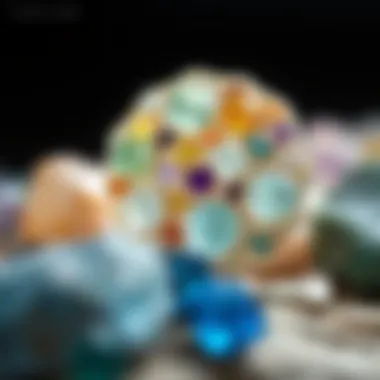

Intro
Washington State is a goldmine for rockhounding enthusiasts. From its rugged coastlines to towering mountain ranges, the diverse geological landscape offers a vast array of collectibles. But the adventure goes beyond mere discovery; it involves understanding the history, identification, and appreciation of various specimens. Whether you're a seasoned collector or just starting, this guide will be your trusty companion on your journey through Washington's rockhounding wonders.
History and Origins
Overview of Collectibles, Rocks, and Fossils
The history of rockhounding in Washington is as rich as the resources found beneath the surface. The state boasts an impressive variety of gemstones, minerals, and fossils, each with unique stories to tell. Collectors often seek out treasures such as agates, jasper, and even the famous Washington State jasper—the latter being particularly prized for its vibrant colors and patterns.
Fossil finds add another layer to this treasure hunt, with locations such as the Olympic Peninsula yielding marine fossils that date back millions of years. These collectibles serve as a tangible connection to the Earth's past. When you hold a well-preserved trilobite, you’re not just holding a rock; you are cradling a piece of history.
Historical Significance and Cultural Impact
Rockhounding is more than a hobby in Washington; it has deeper roots entrenched in the cultural history of the region. For centuries, Native American tribes like the Suquamish and the Blackfeet used local stones for crafting tools, art, and ceremonial items. These practices highlight the intrinsic value of rocks through different lenses—be it practical, artistic, or spiritual.
In recent years, the rockhounding community has grown, influenced by a spirit of conservation and education. Groups like the Washington State Mineral Council emphasize preserving sites while encouraging sustainable collecting practices. This cultural shift indicates an understanding that while collecting is a personal journey, it also involves responsibility toward the environment and cultural heritage.
"Rockhounding in Washington is a blend of excitement, history, and stewardship. Every stone tells a story, and it's up to us to listen."
Identification and Classification
Guide to Identifying Rocks and Fossils
Understanding how to identify rocks and fossils is an essential skill for every rockhound. The state offers a range of minerals, like basalt and obsidian, each with unique characteristics. When hunting for fossils, look for specific traits—texture, color, and size can offer clues about what you’ve found. Utilize resources like field guides and online forums to help sharpen your identification skills. Websites such as Reddit's Rockhounding community provide great tips from seasoned collectors.
Common Types and Variations
Washington is home to a varied geological landscape that supports numerous types of specimens. Here are a few noteworthy finds:
- Agates: Known for their beautiful banding, often found in river beds.
- Jasper: This robust stone comes in many colors and patterns, often sought for jewelry making.
- Obsidian: A volcanic glass that occurs in black or dark hues, prized for its sharp edges.
- Fossils: Marine fossils are commonly found on the coast, with ammonites and trilobites amongst the notable finds.
For a deeper dive into local geology, visiting the Washington Geological Survey can help enhance your understanding of what lies beneath your feet.
Intro to Rockhounding
Rockhounding is more than just a hobby; it's a gateway into the complex geology and vibrant landscapes of our planet. This article aims to illuminate the practice of rockhounding specifically in Washington State, an area rich in geological wonders. Rockhounding allows enthusiasts to engage closely with the natural world, fostering appreciation for the history stamped within every stone and potential treasures waiting to be discovered.
There are several facets to this captivating activity that we will explore in depth. From the practical aspects of where to find specific minerals to understanding the historical context that shapes the landscape today, it’s crucial for collectors, both fledgling and veteran, to have a grasp of the key elements associated with this pursuit.
Definition and Importance of Rockhounding
At its core, rockhounding is the collection of rocks, minerals, and fossils from their natural environment. While some may think of it merely as a way to gather beautiful specimens, its significance runs much deeper. Rockhounding encourages individuals to develop observational skills, technical knowledge, and an appreciation for geology. It becomes a lens through which we learn about earth processes and historical events that shaped our surroundings.
The practice not only aids personal enjoyment but contributes to scientific understanding as well. For instance, when individuals collect data on the types and locations of minerals they find, this information can be invaluable for research and educational purposes. It's not just rocks and minerals; it’s about understanding the science behind them and how they tell stories of past climates and geological activity.
Historical Context of Rockhounding in Washington
Washington State holds a unique place in the history of rockhounding in the United States. Its varied topography boasts mountains, plains, and a rugged coastline, which together form a diverse geological playground. Rockhounding has roots that stretch back to before statehood, when indigenous peoples utilized local materials for tools and ornamentation, revealing an early connection between humans and their natural environment.
As mining boomed in the late 19th and early 20th centuries, many collectors began to take notice of the state's wealth of natural resources. The excitement surrounding gold and silver mining sparked interest in other minerals that were often overlooked. Over the decades, various clubs and organizations dedicated to promoting geology and rockhounding emerged, helping to foster a community of collectors and enthusiasts.
Today, the ethos of rockhounding in Washington is a blend of history, education, and conservation. Collecting practices are guided by regulations aimed at preserving the environment while encouraging the continued pursuit of understanding the planet’s treasures. The mix of history and modern rockhounding philosophies makes Washington a rich study in geology and a prime spot for any rockhounding enthusiast.
Geological Overview of Washington State
Rockhounding in Washington is not just a hobby; it’s a full-fledged expedition into the Earth’s crust. The geological overview of this region serves as the backbone of rockhounding, providing enthusiasts with context, guidance, and a deeper appreciation of what lies beneath their feet. Washington boasts a unique tapestry of geological formations shaped by volcanic activity, glaciation, and tectonic movements, making it one of the prime locations for mineral collectors and geology lovers.
Understanding the geology of Washington is essential for rockhounding because each area offers a distinct set of features and materials for collection. This knowledge not only enriches the experience but also enhances safety and sustainability during exploration. Knowledge of specific areas helps enthusiasts locate promising sites and ensures they comply with regulations designed to protect these valuable landscapes.
Key Geological Formations and Their Features
Washington's geological landscape is characterized by several notable formations and geological features that will captivate any rock enthusiast:
- Cascades Range: A volcanic chain, home to several active volcanoes like Mount Rainier, which contributes a rich variety of volcanic rock.
- Columbia River Basalt Group: This formation consists of a series of immense lava flows, providing unique basaltic specimens perfect for collectors seeking darker, dense stones.
- Olympic Peninsula: Featuring ancient sedimentary rocks, its coastline exposes a myriad of fossils and marine-related minerals.
- North Cascades: Renowned for its complex geology, it showcases the effects of mountain-building processes, which leads to diverse mineralogical richness.
"The geological features of Washington are like a grand library, each rock telling its own story about the Earth’s history."
Each of these formations offers its own story and a chance to collect a diverse array of specimens. It’s crucial for rockhounding enthusiasts to familiarize themselves with these geographical landmarks, as they chart out a roadmap for potential finds.
The Diversity of Minerals Found in Washington
Rockhounding in this vibrant state is not merely about collecting rocks, but uncovering a richness in minerals that can boggle the mind. Washington is home to a plethora of minerals, thanks largely to its varied geological processes. Here are some key examples:
- Agate: Found along riverbeds, these gemstones present an array of colors and patterns.
- Quartz: Multi-faceted, found in forms like amethyst or citrine, especially in volcanic regions.
- Jadeite: A prized find for collectors, particularly in western Washington, given its connection to ancient cultural practices.
- Opal: Often found in areas with volcanic activity, these precious stones present an incredible range of colors.
In addition to these well-known minerals, more obscure specimens like petrified wood and rare elements such as lazurite can be found, enticing collectors with their rarity and beauty. The richness of Washington’s mineral diversity not only offers tangible treasures but also offers a glimpse into the intricate geology that shaped them. Rockhounding here is indeed a blend of curiosity and adventure, as each outing can yield both familiar finds and unexpected surprises.
Best Locations for Rockhounding
Finding the prime rockhounding spots in Washington is akin to discovering hidden gems, quite literally. The significance of these locations cannot be understated, as they determine the variety and quality of specimens that collectors can expect to find. Washington is adorned with diverse landscapes — from mountains and rivers to forests — each contributing to the rich mineral deposits found beneath its surface. Collectors can tap into both public and private sites, each holding its own secrets and opportunities. Knowing where to go not only enhances the experience but also fosters a deeper appreciation of the geological history packed into these rocks.
Public Lands and Parks for Collecting
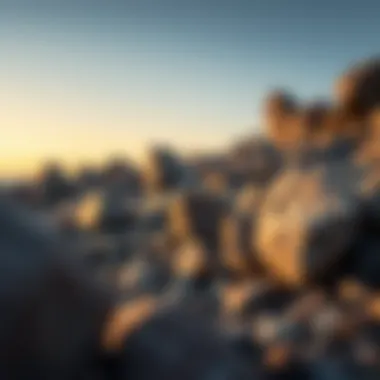
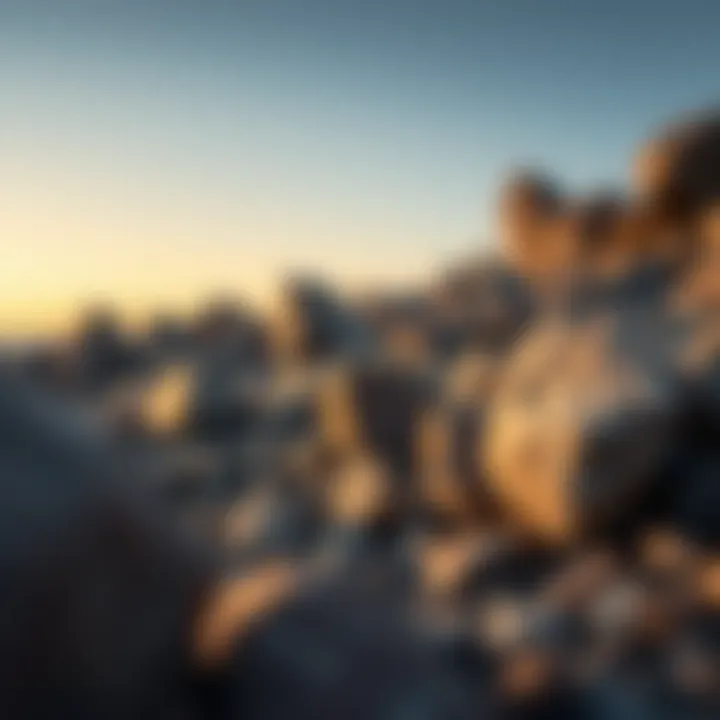
When it comes to public lands, Washington offers a smorgasbord for rockhounds. National parks and forests such as Mount Rainier National Park or the Olympic National Park allow enthusiasts to explore geological marvels without needing special permissions. Here, one can find agates, jasper, and even unique volcanic rocks.
Benefits of collecting in public areas include:
- Accessibility: Many sites are easily reachable, making them great for family outings.
- Diverse Environments: Different terrains mean a variety of specimens. You could find something entirely different in a forest compared to a riverbed.
- Regulations: Often, basic collecting permits can be obtained online or on-site without a hassle.
However, rockhounds must take heed of regulations since certain areas may have restrictions on collection to protect fragile ecosystems. For example, parks like Olympic National Park specifically prohibit rock collecting to preserve its natural beauty. Do check local guidelines to ensure you're in the clear before heading out.
Private Sites and Their Accessibility
In complement to public lands, private sites often present opportunities for finding unique and valuable specimens—though the accessibility can vary. Some landowners welcome collectors with open arms, while others may impose restrictions or charge fees. Notable private sites like the Mason County Rock Club or Crystal Mountain allow rockhounds to dig for beautiful quartz and agate with proper arrangements.
Advantages of private sites include:
- Higher Quality Finds: Many private lands feature deposits that are ripe for collecting.
- Guided Expeditions: Some sites offer guided hunts or workshops, perfect for those eager to learn more.
Before visiting, reach out to the landowners via social media platforms like Facebook or check forums on Reddit for any personal experiences from other collectors.
Seasonal Considerations for Optimal Rockhounding
Seasonality heavily influences rockhounding success in Washington. Each season offers different opportunities; for instance, spring and fall can provide the best conditions for exploring rivers, as melting snow or rainfall may expose fresh deposits. During summer, dry conditions may limit accessibility, but rivers can be perfect for casual surface collecting. Collection during winter might sound impractical, yet hidden treasures can await beneath the snow if you know where to look.
For the best experiences, consider this:
- Timing: Plan your trips around weather patterns; late spring is often recommended for heavy river sedimentation.
- Road Conditions: Some remote locations become muddy and difficult to access during rainy months or after snowfall.
Ultimately, knowing the ins and outs of the seasonal shifts can turn a mediocre trip into a treasure-laden adventure.
"The best time to seek out rocks isn't when it's a sunny day — it's when Mother Nature has done her part to reveal them."
In summary, the best locations for rockhounding in Washington are as varied as the rocks themselves. Public parks offer rich experiences, while privately owned lands often unveil rarer finds. Furthermore, being aware of seasonal changes gives rockhounds an advantage in locating and collecting specimens effectively.
Rockhounding Regulations in Washington
Navigating the world of rockhounding in Washington offers not only the thrill of discovery but also a dash of responsibility. Understanding rockhounding regulations is pivotal. Why? Well, they’re not just legalities to brush aside; they exist to protect our natural resources, ensuring that future generations can also enjoy these geological wonders. Rockhounding regulations encompass laws regarding permits, collecting sites, and conservation efforts, making it essential for every rockhound to be informed.
Permits and Legal Considerations
First things first, let’s talk about permits. Depending on where you're hunting for rocks, you might need one. On state-managed lands, a permit is often essential, and the price usually won’t break the bank. There can also be regulations varying significantly from state to state, and even by locality within Washington, so it pays to stay in the know.
In many areas, collecting small amounts of rocks and minerals for personal use doesn't require a permit. However, once you start to up your haul—in quantity or in method of collection—you could find yourself needing a special permission slip. For example, collecting on certain parks might necessitate a specific allowance, especially in designated nature reserves.
Here are some considerations:
- State Parks: Always check the local park regulations to understand what is allowed and what’s not.
- Federal Lands: If you plan to venture into national parks or forests, be prepared to follow stricter rules. Permits can be required for larger collections.
- Local Ordinances: Each county may have additional rules on top of state regulations.
Before you head out, a quick check of Washington’s Department of Natural Resources website can guide you through the latest legal requirements. The last thing you want is to upset Mother Nature or the law.
Respecting Natural Resources and Conservation Efforts
Rockhounding is a delightful hobby, but with it comes responsibility. It is crucial to respect the natural environment while you're on your quest. Taking care of the earth isn’t just a trend; it’s a necessity. The more we take from the land, the more we have to consider its preservation.
Adopting ethical collecting practices is a must. Here’s how:
- Limit Your Impact: Only collect what you need. Over-collecting can disturb ecosystems and biodiversity.
- Stay on Established Paths: Straying from marked trails can cause damage to delicate vegetation and habitats.
- Use Tools Responsibly: A simple rock pick can do wonders, but using heavy machinery or large tools can lead to major terrain disruption.
- Follow Leave No Trace Principles: When you leave the site, ensure that you take nothing but memories and leave nothing but footprints.
By following these practices, you not only promote conservation efforts but also help maintain the spirit of rockhounding for your peers and future enthusiasts.
“Preserve it today so they can dig it tomorrow.”
For more guidance on conserving natural resources, the Washington Department of Fish and Wildlife website provides excellent information on environmental care when collecting.
Whether you're a seasoned pro or a curious newbie, understanding rockhounding regulations in Washington is key to fostering a sustainable, respectful hobby that cherishes the earth's treasures without jeopardizing them.
Essential Tools and Techniques for Rockhounding
When it comes to rockhounding, having the right tools and techniques can make all the difference between a good trip and an unforgettable one. Equip yourself with the basics, and you’ll be ready to tackle the varied terrains and geological wonders that Washington has to offer. This section not only highlights the essential tools needed for collectors but also shares methods that can enhance your technique, ensuring a fruitful experience.
Must-Have Equipment for Enthusiasts
Starting your rockhounding journey without the proper equipement is like going fishing without a rod. Here’s a handy list of must-have items:
- Rock Hammer: A sturdy rock hammer allows you to break open rocks to reveal hidden treasures inside. Look for one that has a pointed end for prying and a flat end for hammering.
- Chisels: Essential for shaping and cleaning minerals and fossils. Investing in a couple of sizes can help you tackle various projects.
- Safety Gear: This includes safety glasses and gloves. Protecting yourself while working around sharp rocks is crucial.
- Field Guide Book: A good field guide can assist in identifying your finds. There are many specific to Washington’s geology that highlight local rocks and minerals.
- Collecting Bags: Heavy-duty cloth or plastic bags will prevent your finds from breaking during transport.
- Tweezers and Brushes: Small tools like these help in carefully removing soil and other debris from your specimens without causing damage.
- First Aid Kit: Always handy in case of minor injuries while out in the field.
Additionally, anyone serious about rockhounding should consider a GPS Device or a smartphone app to help pinpoint great locations for gathering. For example, an app like Geological Maps can guide you to geological features nearby.
Techniques for Effective Collecting
Proper technique is just as crucial as the tools you use. To really get the most out of your rockhounding adventures, keep the following tips in mind:
- Research Locations: Familiarize yourself with the best spots to find specific minerals or fossils. Resources like local geological surveys or websites such as en.wikipedia.org can provide invaluable information.
- Plan Your Trips Accordingly: Certain times of the year are better suited for collecting due to the weather and visibility. For instance, after a heavy rain, exposed soils can reveal new finds.
- Look for Surface Indicators: Often, rocks or minerals can signal what lies beneath. Take note of distinct color changes in the soil or the type of vegetation, as they might lead you to something special.
- Digging Techniques: Remember to dig carefully, especially in areas where your specimen might be located near fragile formations. It’s advisable to remove the top layer of soil and work your way down, always mindful of the surroundings.
- Preservation Methods: If you stumble upon an unusual find, be mindful of how you handle it. Gentle techniques for cleaning and transporting your objects can’t be stressed enough.
Remember: Ethical collecting is paramount. Always seek permission when collecting on private land and respect any regulations regarding natural heritage.
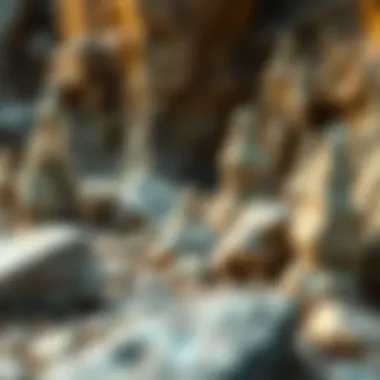
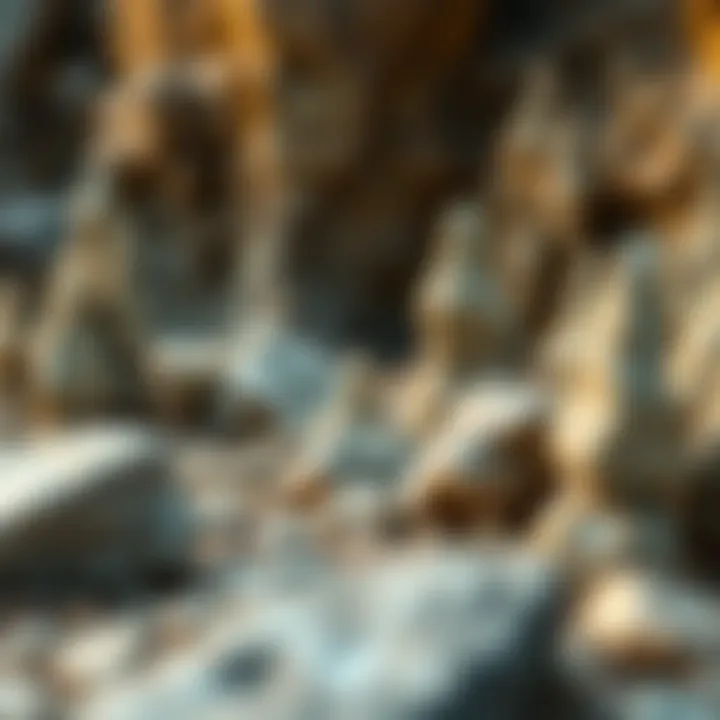
By integrating the right tools and techniques into your rockhounding practices, not only will you maximize your collecting potential, but you’ll also deepen your respect for the natural world around you. With patience and diligence, your next trip could yield treasures beyond imagination.
Identifying Rocks and Minerals
The linchpin of rockhounding lies in the ability to identify various rocks and minerals. This skill is not only essential for enthusiasts but also enriches the entire rockhounding experience. Understanding the intricacies of the geological world allows hobbyists to better appreciate what they collect, differentiating a mundane stone from a gem with potential scientific or monetary value.
Moreover, identification fosters a connection with nature. It unveils the histories embedded within each specimen, from volcanic eruptions to ancient ocean floors. This knowledge is vital because it aids in informed collecting, ensuring one neither takes specimens that are rare or protected nor leaves behind valuable finds. When a rockhound is equipped with the ability to identify their discoveries, each outing transforms from a mere search to an enlightening journey.
Manuals and Resources for Identification
Navigating the vast world of rocks and minerals can feel overwhelming, especially for those new to rockhounding. Fortunately, there are numerous resources available to make this journey smoother. Guides such as "Rocks and Minerals of Washington State" offer detailed descriptions and high-quality images. These publications often include essential identification points—color, luster, hardness, and streak—that can dramatically simplify the process.
In addition to print resources, online platforms serve as invaluable tools. Websites like Wikipedia and Britannica provide a wealth of information on specific minerals. Forums on Reddit and groups on Facebook can connect collectors with fellow enthusiasts, sharing tips and photos to aid in identification.
For those looking for mobile assistance, apps like Rock Identifier utilize modern technology to help users identify their finds with just a snapshot. This blend of traditional manuals and cutting-edge tech paves the way for a more engaging and educational rockhounding expedition.
Commonly Found Specimens in Washington
Washington is a veritable playground for rockhounds, with a plethora of specimens that can be found across the state. Some commonly encountered rocks and minerals include:
- Thundereggs: These volcanic rock formations often harbor beautiful crystals within their centers, making them a prized find.
- Agate: Known for their striking colors and patterns, agates are quite prevalent in areas like the Columbia River.
- Jasper: This opaque form of chalcedony comes in various colors and patterns, often found in riverbeds and gravel pits.
- Gold: While it requires a keen eye and special techniques to find, panning in riverbeds can yield exciting results.
Each specimen tells a story, providing insight into the geological processes that shaped them. Learning about these commonly found rocks empowers rockhounds to discern between what's available and what's truly special. The excitement of recognizing a unique find—something that might just spark further interest—makes every collecting trip notable.
Identifying rocks is about more than mere collection; it's a gateway to understanding the planet's history and mysteries.
To delve deeper into specific minerals or for identification resources, consider exploring Washington State University’s geology resources at wsu.edu or the United States Geological Survey at usgs.gov. These platforms can provide excellent groundwork for further exploration.
Valuation of Collected Specimens
When you find a stunning piece of quartz or an unusual agate, the thrill of discovery is only part of the experience. The question of valuation comes next for many enthusiasts—how much is this specimen worth? Understanding the valuation of collected specimens is crucial not just for financial reasons, but also for appreciating the unique history and significance of your finds.
Knowing how to assess the value of your rocks and minerals can enhance your enjoyment of rockhounding. It can also assist you in making informed decisions about where to sell or trade your finds. An accurate valuation can spur conversations with fellow collectors, heighten your appreciation of geology, and even influence relationships within rockhounding communities.
Factors Influencing Value
Determining the worth of any rock or mineral is not as straightforward as one might think. Several key factors come into play:
- Rarity: Just as some gemstones like diamonds are rare and sought after, some minerals are more uncommon than others. Rarity can significantly inflate the value of a specimen. For instance, finding a desert rose selenite is far less common than quartz.
- Quality: This encompasses clarity, color, and any unique patterns. A well-formed crystal will fetch higher prices compared to a dull, fragmented piece. For example, a polished amethyst geode would generally carry more value than a rough, uncut version of the same stone.
- Size: Larger specimens can be more valuable but size alone does not make a piece valuable. A big, imperfect chunk of rock won't hold up against a smaller piece with exceptional quality and appeal.
- Provenance: The history of a specimen can elevate its value. If you can trace a mineral back to a notable location or event, collectors may pay more for it. For instance, minerals from specific mines, like the famous mines in the Washington Cascade range, can be of special interest.
- Demand: Much like any marketplace, the value can fluctuate based on what collectors are actively seeking. Trends change, influenced by social media and the online community. Following enthusiasts’ forums on sites like Reddit can provide insight into what is currently desirable.
Where to Sell or Trade Your Finds
Once you’ve assessed the value of your collected specimens, the next step is to find a marketplace or community that aligns with your needs. Here are several avenues to consider:
- Rock and Mineral Shows: Local or national events often feature vendors and collectors who buy and sell specimens. These shows can be a great way to meet other enthusiasts and make trades.
- Online Marketplaces: Websites like eBay or Etsy allow you to reach a wider audience. Buyers come looking for specific items, making it easier to trade or sell your more valuable finds.
- Specialized Clubs and Societies: Joining local rockhounding clubs can be helpful. Members often organize trades or sales among themselves, providing a supportive community where you can learn and share knowledge.
- Local Shops: Some local geological shops or craft stores purchase collectibles. It might not always fetch the highest price, but it can be a straightforward option to turn your find into cash.
Ultimately, the valuation process should be regarded as a fascinating journey, one that not only increases your understanding but also connects you deeper with the natural world. By mindful of your collections, you can make thoughtful decisions that resonate with both your personal enjoyment and your rockhounding aspirations.
"The world is full of rocks that tell a story; valuation is merely the means to understand their worth in the grand tapestry of nature."
For further resources and community tips, visit Rockhound.com or explore discussion forums on Reddit.
Caring for Collected Rocks and Minerals
Caring for your collected rocks and minerals isn’t just about storage; it’s a vital part of preserving the beauty and integrity of your finds. Each specimen tells a story of its geological journey, and thus, maintaining their condition is essential not only for personal enjoyment but also for future appreciation. Whether you're a weekend wanderer or a dedicated collector, knowing how to care for your treasures can make a world of difference in their longevity.
Proper Storage Techniques
When it comes to storing collected specimens, the first step is to find a space that protects them from environmental factors. Here are some key storage techniques to consider:
- Temperature Control: Extreme heat or cold can cause minerals to crack or degrade. Aim for a stable temperature around room temperature.
- Humidity Levels: Too much moisture can lead to mold or damage, especially with softer minerals. Utilizing silica gel packets can help absorb excess humidity.
- Material Selection: Store your specimens in breathable containers, such as cardboard boxes or trays, rather than plastic which can trap moisture.
- Avoid Direct Sunlight: Keep your rocks in a shaded area. UV rays can fade colors and degrade delicate minerals.
Make sure to label your storage containers for easy identification when you want to showcase or revisit your collection.
Cleaning and Maintenance Recommendations
Over time, your rocks may collect dust or dirt from the field, so periodic cleaning is essential to keep them in their best form. Here are some recommendations for cleaning:
- Gentle Cleaning: Use a soft brush or a microfiber cloth to dust off your specimens. Harsher tools can scratch or damage the surface.
- Water Wash: Most minerals can be rinsed in lukewarm water, but avoid soaking them for prolonged periods. For stubborn dirt, a gentle soap can be used, but rinse thoroughly to prevent residue.
- Chemical Cleaners: Be cautious with chemical cleaners. If you decide to use acids or other strong agents, do so on a small, inconspicuous area first to ensure it doesn't harm the specimen.
- Regular Inspection: Keep an eye on your collection for any signs of deterioration. Addressing issues like cracks or chips early can save a dear piece.
By incorporating these storage and maintenance practices into your rockhounding routine, you can enjoy your collected specimens for years to come, basking in the beauty and stories they bring from deep within the earth.
"A well-cared-for collection is not just about aesthetics; it’s an investment in geological history and personal experience."
For further reading on storage techniques and cleaning methods, consider visiting educational resources like Wikipedia, or join discussions on platforms like Reddit, where enthusiasts share tips and experiences.
Role of Technology in Rockhounding
In the digital age, technology has seeped into nearly every facet of our lives, and rockhounding is no exception. The advent of smartphones, apps, and online platforms has transformed how enthusiasts engage with their hobby. Technology not only enhances the rockhounding experience but also carries significant benefits, enabling collectors to gather information, share their findings, and navigate more effectively in the field.
Apps for Rockhounding and Navigation
In an era where information is literally at our fingertips, mobile applications have become invaluable to rockhounds. For instance, using the Rockhound App, one can locate nearby collecting sites, document finds, and even identify specimens in real-time. This app goes beyond just marking locations—it provides details on the types of minerals found in the area, which can significantly enhance a day's outing.
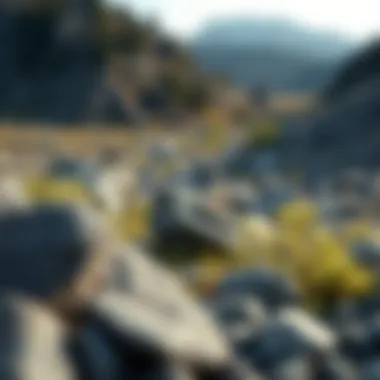
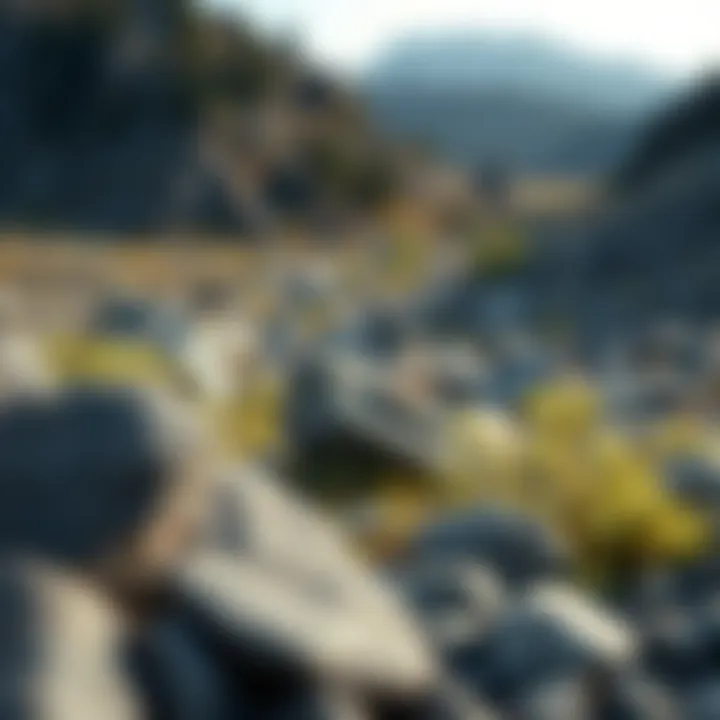
Moreover, navigation apps like Google Maps or AllTrails offer functionality that ensures enthusiasts can reach both new and familiar rockhounding spots without getting lost. With features like offline maps, users can plot their journeys without relying on cellular service, an essential feature when exploring remote areas.
When considering which apps to download, here are a few standouts:
- Rock Identifier: Uses image recognition to help identify rocks on the spot.
- Geology Toolkit: Offers geological maps and rock formation information.
- Mineral Tracker: Great for cataloging specimens and tracking their values over time.
"With the right tools and apps, rockhounding becomes much more than just a hobby; it turns into an exhilarating treasure hunt where knowledge is just as valuable as the finds themselves."
Using Online Communities and Resources
The internet is awash with communities and resources dedicated to rockhounding, providing an incredible repository of knowledge. Websites like Reddit's Rockhounding forum or Facebook groups focused on geology are perfect for connecting with fellow enthusiasts. These platforms create spaces for information exchange, where users can share tips, post their latest finds, and get advice on specific locations.
In addition, leveraging educational resources such as the National Park Service (nps.gov) can help collectors understand local regulations, conservation efforts, and the geological significance of different regions. Such insights are invaluable for responsible collecting.
Here are a few noteworthy online platforms and resources to bolster your rockhounding journey:
- The Mineralogical Society of America: Provides detailed guides on various minerals and resources for rockhounds.
- Mindat.org: A comprehensive database for mineral collectors, including photographic galleries and locality information.
- Facebook Groups: Search for local or national groups dedicated to rockhounding to get real-time updates and engage with a broader community.
The combination of technology and community engagement serves to elevate the experience of rockhounding. With so many resources at one’s disposal, the adventure becomes not just about collecting rocks, but about expanding knowledge and fostering connections within a passionate community.
Rockhounding Events and Clubs in Washington
Rockhounding events and clubs in Washington serve as vital hubs for enthusiasts to connect, learn, and share their experiences. These gatherings foster a sense of community among collectors, provide education on various techniques, and offer firsthand insights into the intricacies of rockhounding. The importance of these events cannot be understated, as they not only enhance individual skills but also promote sustainable practices within the rockhounding community. For both newcomers and seasoned collectors, engaging in these events opens the door to a wealth of knowledge and the chance to network with other passionate individuals.
Local Clubs and Their Activities
In Washington, numerous local clubs are dedicated to the art and science of rockhounding. These clubs often organize regular meetings, field trips, and workshops, creating opportunities for members to exchange tips and tricks. One prominent club is the Pacific Northwest Fossil Club, which holds monthly meetings to discuss various fossil finds and share identification techniques among members. Clubs, such as the Everett Rock and Gem Club, host annual rock shows and educational seminars—events where one can learn about mineral identification, tools for collecting, and the dos and don’ts of ethical rockhounding.
- Meetings: Members gather to discuss their recent adventures, trade specimens, and plan future trips.
- Field Trips: Organized trips to specific locations, often guided by experienced members, allow participants to explore new ground.
- Workshops: Educational sessions focus on topics like polishing techniques, the geology of specific areas, and preservation methods.
Joining a local club can significantly enhance one’s rockhounding experience. Not only do you gain access to a treasure trove of information, but you can also find camaraderie among fellow collectors.
Annual Rockhounding Events and Expos
Each year, Washington hosts several annual rockhounding events and expos, drawing enthusiasts from across the state and beyond. These events are not just showcases for specimens; they also include educational segments that inform attendees about geology, rock and mineral identification, and recent finds in the area.
For instance, the Washington State Mineral Council organizes the Rockhound Expo, which features various vendors selling tools, books, and specimens, alongside guest speakers who share their expertise in geology and collecting. Another notable event is the Northwestern Mineral Expo, where collectors can participate in workshops and attend lectures on a range of topics, from identifying rare minerals to understanding the impacts of climate change on local geology.
"Attending these expos not only enriches your knowledge but also offers the chance to win unique specimens in raffles and networking opportunities with traders and hobbyists alike."
In summary, participating in local clubs and annual events helps to cultivate a rich rockhounding culture in Washington. Being active in these communities encourages responsibility in collection habits, promotes learning, and connects rockhounds with others who share their passion. Resources for finding clubs and events can often be found on sites like Rockhounding Washington or community boards on platforms like Facebook. Engaging with fellow enthusiasts not only expands one’s collection but also deepens the appreciation for the natural world.
Challenges and Considerations
Rockhounding, while often lauded as a rewarding hobby for those who possess a keen interest in geology and natural history, is not without its challenges. Understanding the ethical and environmental considerations is paramount for anyone who wishes to engage responsibly in this captivating pursuit. Not only does this section highlight the critical elements that must be weighed before embarking on a rockhounding endeavor, but it also emphasizes the profound impact individuals can have on both their surroundings and their community.
Environmental Impact and Ethical Collecting
When one views the stunning landscapes of Washington, it’s easy to become enamored with the beauty and diversity offered. However, it’s important to approach rockhounding with care. Each rock and mineral is not just potential treasure; it’s part of a delicate ecosystem. Adopting a mindset of ethical collecting can mean the difference between responsible stewardship of natural resources and unwarranted damage.
Key considerations include:
- Limited Collection: Collect only what you can responsibly carry and should intend to cherish. Leaving enough for others ensures that resources remain available and habitats are preserved.
- Respect for Wildlife: Many rockhounding sites are also habitats for wildlife. Disturbing these areas can have detrimental effects on the flora and fauna.
- Legal Guidelines: Familiarize yourself with local regulations regarding rockhounding. Many regions have specific rules designed to protect geological features and their surrounding environments.
"One should always tread lightly, collecting with intention and respect, aware that nature deserves both admiration and protection."
Being conscientious about the environmental impact of rockhounding not only preserves natural beauty for future enthusiasts but also fosters a culture of awareness and respect.
Identifying and Avoiding Dangers in the Field
While the thrill of discovery may overshadow many concerns, the reality is that rockhounding can pose certain risks—especially for those venturing into remote or rugged areas. Ensuring a safe experience is as crucial as the hunt for unique specimens. To navigate the potential dangers effectively, it’s indispensable to remain alert and prepared.
Common dangers to keep in mind include:
- Hazardous Terrain: Uneven ground, loose rocks, and steep slopes can easily lead to falls or injuries. Always assess the physical conditions of your surroundings and take caution with each step.
- Weather Conditions: Washington has varied climates. Sudden rains can make trails treacherous. Always check the forecast and bring appropriate gear.
- Wildlife Encounters: When wandering through nature, one must keep an eye out for potential wildlife encounters, whether dealing with snakes or larger animals. Knowing how to react can minimize risks.
- Getting Lost: The beauty of the outdoors can sometimes cloud direction. Carrying a map, compass, or GPS device is wise to ensure you remain oriented.
Rockhounding can serve as a beautiful blend of adventure and education, but awareness of safety can ensure that the focus remains on the rocks rather than mishaps in the field. Not only will taking precautions enhance satisfaction, but it can also lead to more fruitful collecting experiences. By embracing the responsibilities of environmental stewardship and personal safety, rockhounding can foster deep connections not just with the minerals, but also with the land itself.
Culmination and Further Exploration
In wrapping up this thorough discussion on rockhounding in Washington, it’s clear that this activity goes beyond just collecting stones; it is about immersing oneself in the natural beauty and geological history of the region. Understanding the implications of rockhounding—from legal aspects to ethical collecting practices—enriches the experience, making it meaningful on multiple levels.
Exploring Washington's diverse geological formations not only adds value to individual collections but also fosters a greater appreciation for the conservation of these natural resources. Recognizing the unique minerals and rocks available throughout the state allows rockhounds to connect with the land in a profound way. Additionally, accountability in these pursuits ensures that future generations can also discover and enjoy these treasures.
"Rockhounding isn’t just about finding treasures; it’s about respecting and preserving the environment they come from."
Recap of Key Points
As we conclude, let’s briefly revisit some key points discussed:
- Washington State is characterized by a variety of geological formations, rich in minerals that excite both novice and experienced rockhounds.
- Compliance with local regulations ensures sustainable collecting practices and helps preserve the environment.
- Proper tools and techniques are essential for effective rockhounding, whether one is rummaging through riverbeds or exploring mountain terrains.
- Understanding the value of the collected specimens can lead to opportunities for selling or trading within a community of like-minded enthusiasts.
- The role of technology and online resources has expanded the horizons for rockhounds, making information and community support more accessible than ever.
Resources for Continued Learning
To keep the exploration going, several resources can provide ongoing education and community engagement:
- See Reddit for forums that discuss various topics specific to enthusiasts and allow for sharing experiences.
- Check out National Parks Service for guidelines on collecting in protected areas.
- Websites like Mindat.org offer detailed mineral databases that can help with identification and valuation of your finds.
- Join local rockhounding clubs and associations to find events and connect with fellow rock enthusiasts, such as the Washington State Mineral Council.
- Each year, attend rock and mineral shows frequently listed in community calendars and on Facebook groups, fostering a sense of community and providing practical tips.
Arming yourself with knowledge ensures that your rockhounding adventures are not only enjoyable but enriching in more ways than one. Whether you’re picking up your first agate or discovering rare quartz crystals, every trip can lead to new learning experiences.



